The Metropolitan's holdings of art from sub-Saharan Africa, the Pacific Islands, and the Americas are today regarded as canonical. They constitute such an integral part of the institution that few realize their inclusion is the result of the vision and sustained efforts of a uniquely influential figure in both American political life and the New York art scene: Nelson Aldrich Rockefeller (1908–1979). The scion of one of the nation's most significant philanthropic families, Rockefeller served as vice president from 1974 to 1977 under Gerald R. Ford and was elected to four consecutive terms as governor of the State of New York between 1959 and 1973.
Key formative influences for Rockefeller were his mother, Abby Aldrich Rockefeller, a founder of the Museum of Modern Art, and his travels. His passion for collecting included modern art, Far Eastern sculpture and painting, and Precolumbian, South Sea Islands, and African art. In 1930, when he graduated from Dartmouth College, he became a member of the board of the Metropolitan Museum. The Metropolitan's lack of interest in avant-garde art had been a catalyst for the establishment of the Museum of Modern Art the year before. Rockefeller advocated for Precolumbian art, another notable absence in the Met's holdings, but his efforts were thwarted by the Met's director, Herbert Winlock. With the encouragement of René d'Harnoncourt, Rockefeller founded a cultural organization devoted to these neglected artistic traditions. The scope of this "Salon des Refusés" was vast, encompassing an array of non-Western art traditions. In its initial 1954 charter, this pioneering venture was named the Museum of Indigenous Art. Located in a townhouse adjoining Rockefeller's boyhood home across from the Museum of Modern Art at 15 West Fifty-fourth Street, it later became known as the Museum of Primitive Art.
Over the course of two decades, the collection of the arts of Africa, Oceania, and the Americas at the Museum of Primitive Art became the most important ever assembled. It was shaped by Rockefeller's quest for aesthetic excellence across a vast spectrum of traditions. The museum's co-founder and vice president, René d'Harnoncourt, recruited the art historian Robert Goldwater as director, and together they assisted Rockefeller in realizing his goal of establishing these traditions as fine arts in the West. Toward this end, Goldwater oversaw an extensive program of landmark exhibitions. Before his death in 1968, d'Harnoncourt served as an emissary on behalf of Rockefeller in brokering an agreement with Thomas Hoving, the director of the Metropolitan, to create a department encompassing the holdings of the Museum of Primitive Art and Rockefeller's personal collection. When the Museum of Primitive Art closed in December 1974, its library, its staff, and 3,500 works were transferred to the Michael C. Rockefeller Wing at the Metropolitan. Nelson Rockefeller died before the wing, dedicated to the memory of his son, opened to the public in 1982.
Sixty years after the founding of the Museum of Primitive Art, the arts of Africa, Oceania, and the Americas occupy a place of prominence at the Metropolitan, fulfilling Rockefeller's vision.
The exhibition is made possible by the Friends of the Department of the Arts of Africa, Oceania, and the Americas.
The publication is made possible by The Peter Jay Sharp Foundation.
The Metropolitan's quarterly Bulletin program is supported in part by the Lila Acheson Wallace Fund for The Metropolitan Museum of Art, established by the cofounder of Reader's Digest.
Between 1949 and 1956, René d'Harnoncourt was Nelson Rockefeller's closest collaborator in shaping his collection of "primitive art." In order to strategically assemble what would become one of the world's great holdings of non-Western art, d'Harnoncourt devised a systematized process for charting acquisition goals. To complement Rockefeller's discerning and adventurous eye as a collector, d'Harnoncourt established a template for the collection that took the form of four loose-leaf notebooks titled Catalog and Desiderata devoted to African, Oceanic, Native American, and Precolumbian arts.
The notebooks feature sketches by d'Harnoncourt—an expert draftsman—and thumbnail photographs. The drawings reproduce works published in the seminal books and exhibition catalogues that he considered "ideal" examples of specific genres to be attained for the Rockefeller collection. Photographs were added as works in these categories were acquired from New York private galleries. Each notebook includes a map and bibliography. Given that d'Harnoncourt was well versed in the arts from the Americas, he did not feel the need to rely on this system for that area to the same degree as for Africa and Oceania. Accordingly, the two notebooks dedicated to the Americas are comparatively thin. The notebooks document the development of the canon of "primitive art" during the first half of the twentieth century as well as New York's market for these arts during the 1950s.
We must learn what we can of all these works so that we may learn to look at them. But finally what we know about them can only enrich, not fundamentally alter, our penetration of the emotional meaning of what they are.
—Robert Goldwater
To fulfill his vision of a collection that would establish incontrovertibly that the achievements of artists from Africa, Oceania, and the Americas were comparable to those of their peers throughout history and across the globe, Rockefeller gathered around him the most knowledgeable advisors possible. Among them was Robert Goldwater, who became director of the Museum of Primitive Art in fall 1956. Goldwater first encountered non-Western art through the lens of modernism and as a prominent art critic. In contrast to d'Harnoncourt's method of prioritizing Rockefeller's acquisitions in the early 1950s, Goldwater initiated a professionalized acquisition process for making recommendations. Goldwater enforced a strict art-historical approach that blended a keen awareness of a work's aesthetics with thorough research on the context of its larger cultural significance.
Documents relating to acquisitions made by the Museum of Primitive Art before and after 1956 reveal two distinct methodologies. While d'Harnoncourt focused his concept of "primitive art" on an established typology and on acquisitions made from a small number of sources, Goldwater substantially broadened those frames of reference. He reached out to colleagues throughout Europe and America for information and expertise and widened the network of vendors from whom the Museum of primitive Art made purchases. As the ambition of Rockefeller's collecting became known, increasing numbers of exceptionally important works were proposed to him for acquisition. Goldwater and his staff vetted and provided a preliminary review of what ultimately became landmarks of the collection.
Nelson Aldrich Rockefeller was a passionate collector of art of all kinds. He was especially responsive to sculpture, noting, "I'm interested in the strength, the vitality of it, the fact that you can touch it." His collection of modern art was extensive yet personal. In contrast, his method for assembling works of art from Africa, Oceania, and the Americas was highly systematic. From the beginning he focused on these works as fine art. This emphasis on aesthetic quality was the institutional criteria that defined the Museum of Primitive Art. The curator Douglas Newton noted that unlike other museums of the day that privileged ethnological or anthropological interests for their collecting, "We look for quality within each element—the best of everything."
Beginning in 1957 Robert Goldwater began providing Rockefeller with a steady stream of carefully considered memos regarding recommended purchases. Prior to sending these formal rationales for acquisitions, he reviewed these with René d'Harnoncourt. Among the most expansive of these was a proposal dated December 31, 1957, making the case for his acquisition of the Ivory Pendant Mask from the Court of Benin that is among the Metropolitan's most celebrated masterpieces. In his brief he argued for its superiority to the celebrated example in the British Museum: "I believe this mask surpasses it in delicacy of workmanship and penetration of expression. It is thus the best object of its kind known, nor will any others ever turn up." In arguing for its transformative importance to the MPA collection he compared it to what was then one of the most recognizable works in MoMA's collection, a painting by Henri Rousseau: "the purchase of this mask would give the Museum a permanent, primary attraction—a popular masterpiece. It is one of those objects that "has to be seen" by scholars, art lovers, and the public alike. As René has suggested, it is the kind of object that would . . . have to be put permanently on view; like the 'Sleeping Gypsy' of primitive art."
In 1958 the New York Times announced Nelson Rockefeller's acquisition of the Benin Ivory Pendant Mask for a record price. For Goldwater this singular acquisition came to "crystallize a policy." From this time forward he recommended that the MPA mission be that of "A Museum organized around permanent exhibition galleries where outstanding masterpieces of each area will be continuously accessible to the public, and other galleries with changing exhibitions."
In the Museum of Primitive Art's spring 1957 inaugural exhibition, Goldwater underscored, "We are aware of our kinship with all mankind." This humanist approach to the arts of Africa, Oceania, and the Americas informed the some seventy subsequent exhibitions organized by the MPA, and its nearly sixty publications. The museum itself was pocket-sized, but the impact its exhibition program had on non-Western art museography, collectors, and the public was tremendous. The exhibitions varied from selections of recent acquisitions to works on loan from local collectors to focused thematic installations. Those exhibitions that investigated every aesthetic aspect of a specific culture, such as Bambara Sculpture from the Western Sudan (1960); Senufo Sculpture from West Africa (1963); and The Jaguar's Children: Pre-Classic Central Mexico (1965); had an especially enduring impact.
The works Nelson Rockefeller collected remained inextricably tied to the places they were made—places he enjoyed visiting to learn more about the world. The role of the Museum of Primitive Art was to generate outreach and inspire pride abroad among those countries of origin.
Rockefeller's first love was Precolumbian art. Beginning in the 1930s he traveled extensively in Mexico and Latin America, dedicating his energies toward fostering economic development. Under President Roosevelt he was appointed to the newly created position of Coordinator of Inter-American Affairs (1940) and later served as Assistant Secretary of State for American Republic Affairs (1944).
Rockefeller first traveled with his family to Africa in 1956. On September 30, 1960, he acted as President Eisenhower's representative, leading the U.S. delegation at Nigeria's independence. A highlight of that visit was spending time with Kenneth Murray, Surveyor of Antiquities, and Bernard Fagg, archaeologist and curator, at the National Museum in Lagos.
To celebrate independence across the continent after this trip, the MPA mounted the exhibition The Traditional Arts of Africa's New Nations in 1961. The transition from colonialism to independence was also heralded through the loan of twenty-three major African works from the MPA to L'Art Nègre, which opened in Dakar, Senegal, in 1966 and subsequently went to Paris in conjunction with the First World Festival of Negro Africa, presided over by President Léopold Sédar Senghor.
Nelson's son, Michael, shared his father's passion for non-Western art. After graduating from Harvard University in 1960, he traveled to Papua New Guinea with the Peabody Museum of Archaeology and Ethnology to make a documentary film. Michael stayed on to research and collect the art of the Asmat peoples. During a later visit to the region, his life was tragically cut short when he disappeared during a boating accident. The more than six hundred works he gathered were first presented in the 1962 MPA exhibition The Art of the Asmat, New Guinea: Collected by Michael C. Rockefeller and are today enshrined in the wing as his legacy.
For Oceania, the MPA's most prominent engagement with the original sources of its masterworks was Michael C. Rockefeller's collecting and research among the Asmat people of New Guinea. In 1961 Michael Rockefeller, already an MPA Trustee, joined the Harvard-Peabody New Guinea Expedition to the island's western highlands. During the expedition, he traveled the Asmat region on the southwest coast and spent three weeks acquiring works for the museum and documenting and photographing Asmat art and cultural practices. Following a brief trip home, he returned in September 1961, collecting works in numerous Asmat villages before tragically losing his life on November 18.
Michael Rockefeller's extraordinary accomplishments are reflected in the breadth, quality, and meticulous documentation of his Asmat collection, which contains more than six hundred works, including the towering bis (ancestor) poles that are a focal point of the Metropolitan's Oceanic galleries. To honor Michael Rockefeller's achievements, the MPA staged the 1962 exhibition The Art of the Asmat, New Guinea: Collected by Michael C. Rockefeller. Held in a specially constructed pavilion in the courtyard of the Museum of Modern Art, it presented works from the collection together with a selection of his evocative photographs of Asmat life and art.
The Museum of Primitive Art and the artistic traditions it presented gained acceptance as it grew. Acquisitions continued at a steady pace to reach 3,500 works that were included in the growing lineup of exhibitions and publications. The 54th Street building where the Museum of Primitive Art had been housed since its opening was full of works, books, and staff members, and by the end of the 1960s it had become clear that it needed to become part of something else or become something else.
On May 10, 1969, an exhibition of the Museum of Primitive Art's collection opened at The Metropolitan Museum of Art. Titled Art of Oceania, Africa, and the Americas from The Museum of Primitive Art, it featured eight hundred works displayed in more than seventeen rooms and was described at the time as "the most important exhibition of primitive art ever held." During the press conference, Governor Rockefeller announced that the collection of his museum would be integrated into that of the Metropolitan. That year, to punctuate the end of an era, Rockefeller made his final important acquisition of Precolumbian art: the ensemble of more than one hundred gold, silver, and copper ornaments from the Moche Loma Negra culture. It took thirteen years for the Michael C. Rockefeller Wing to be built; its galleries opened to the public in 1982.
Nelson A. Rockefeller (1908 Bar Harbor, Maine–1979 New York, N.Y.)
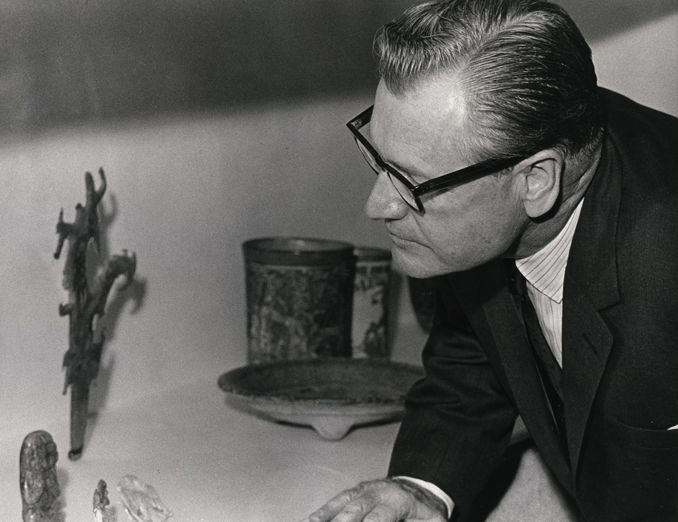
Scion of one of the nation's most significant philanthropic families, Rockefeller was elected to four consecutive terms as governor of New York (1959–73) before serving as vice president of the United States under Gerald Ford (1974–77). His political legacy was matched by his involvement in the New York art scene. He served as trustee, treasurer, president, and chairman of the board at the Museum of Modern Art; trustee at The Metropolitan Museum of Art; director of the Office of Inter-American Affairs; and assistant secretary of state for American Republic Affairs. With d'Harnoncourt and Goldwater, Rockefeller assembled one of the world's most renowned collections of African, Oceanic, and Precolumbian art, which he made public in 1957 with the opening of the Museum of Primitive Art. In 1969 he gave the collection to the Metropolitan, where it has been housed in the wing named in honor of his late son, Michael A. Rockefeller, who shared his passion for art.
Photograph by Michael Fredericks
René d'Harnoncourt (1901 Vienna, Austria–1968 Long Island, N.Y.)

Educated in Graz and Vienna, d'Harnoncourt had aspired to be a chemist. After World War I, he moved to Mexico, where by 1927 he had begun selling antiques and contemporary art. He developed a keen interest in Mexican folk art, which he featured in a groundbreaking exhibition at the Metropolitan Museum in 1930. In 1936 he was appointed general manager of the Indian Arts and Crafts Board. Five years later he joined the Museum of Modern Art, eventually serving as its director (1949–67). A personal advisor to Nelson Rockefeller, d'Harnoncourt was a formative influence behind the Metropolitan's collection of African, Oceanic, and Precolumbian art.
Photo © Waintrob, Budd Studio, courtesy of The Waintrob Project Project for the Visual Arts
Robert Goldwater (1907 New York, N.Y.–1973 New York, N.Y.)

Goldwater's pioneering dissertation at Harvard University, Primitivism and Modern Painting (1938), charted the influence of African, Oceanic, and American precolonial traditions on twentieth-century art in the West. Goldwater reviewed the Museum of Modern Art's 1935 landmark exhibition of African art and in 1957 co-curated its "Modern Art in Your Life" with d'Harnoncourt. He taught art history at New York University and Queens College. In 1956 Goldwater was appointed director of the Museum of Primitive Art. Until his death, he oversaw the museum's extensive program of landmark exhibitions, many of which helped to establish the canon of what was then called "primitive" art.
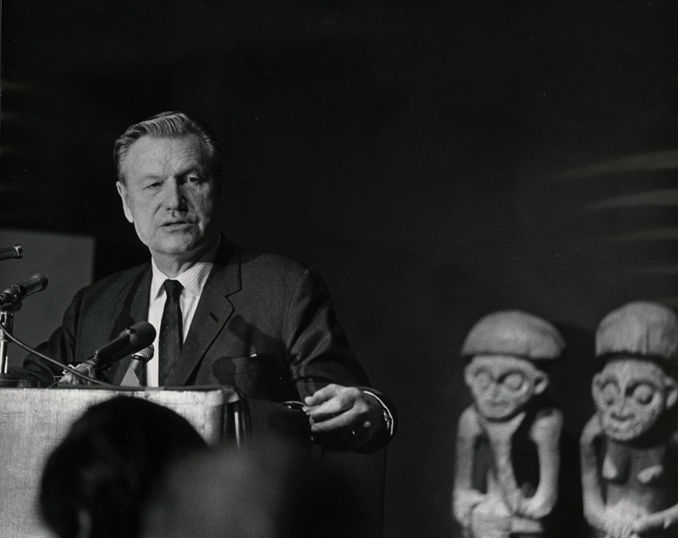
Nelson A. Rockefeller during a 1969 press conference at the Metropolitan Museum of Art, with a pair of Bamum figures from Cameroon. Photograph by Michael Fredericks.
1930: Nelson Rockefeller, visiting Hawai'i on his around-the-world honeymoon, acquires his first work of "primitive" art, a Hawaiian bowl.
1932: Rockefeller becomes a Trustee of both The Metropolitan Museum of Art and the Museum of Modern Art.
1933: Rockefeller visits Mexico for the first time.
1935: Exhibition African Negro Art is presented at MoMA and has a profound effect on the future leadership of the Museum of Primitive Art.
1937: Rockefeller travels to South America, where he particularly admires Peruvian antiquities.
1939: Rockefeller acquires a group of Peruvian ceramic bowls in Buenos Aires, Argentina.
1940: Twenty Centuries of Mexican Art opens at MoMA in cooperation with the Mexican government. Rockefeller becomes President of MoMA's Board of Trustees.
ca. 1940: Nelson Rockefeller meets René d'Harnoncourt in New York.
1941: Indian Art of the United States opens at MoMA, organized by René d'Harnoncourt, then general manager of the Indian Arts and Crafts Board, and Frederic H. Douglas.
1941–45: As coordinator of the Office of Inter-American Affairs, Rockefeller travels widely in Latin America.
1942: Rockefeller proposes to the Trustees of MoMA the formation of a collection of folk and indigenous art of the New World, including painting, sculpture, ceramics, textiles, and other objects of applied arts.
1944: MoMA hires René d'Harnoncourt as Vice President in charge of foreign affairs and Director of the Department of Manual Industries.
1946: Arts of the South Seas, organized by René d'Harnoncourt in collaboration with Ralph Linton and Paul Wingert, opens at MoMA.
1949: d'Harnoncourt becomes Director of MoMA.
1949: Rockefeller acquires his first works of African, American Indian, Oceanic, and Precolumbian art from dealers in New York and Los Angeles.
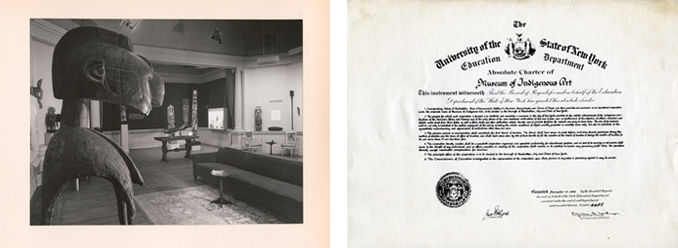
Left: View of exhibition Primitive Sculpture from the Nelson A. Rockefeller Collection, Century Association, New York City, January 7 to March 1, 1953. The Metropolitan Museum of Art, Robert Goldwater Library, K2 N495 Spec Coll. Right: Original charter for the Museum of Indigenous Art, December 24, 1956. The Museum of Primitive Art Records, The Department of the Arts of Africa, Oceania, and the Americas, The Metropolitan Museum of Art, New York, AR.1999.9.6.
1953: Primitive Sculpture from the Collection of Nelson A. Rockefeller, the first exhibition drawn from the Rockefeller Collection, opens at the Century Association, New York City.
1954: Ancient Arts of the Andes, a major international loan show, including works from the Rockefeller collection, opens at MoMA, organized by d'Harnoncourt and archaeologist Wendell Bennett.
Museum of Indigenous Art, on West 54th Street in New York, is chartered as an educational corporation, "the first of its kind in the world." Rockefeller and d'Harnoncourt are principal officers.
September 1956: Robert Goldwater is appointed Director of the Museum of Indigenous Art.
December 1956: Museum of Indigenous Art is formally renamed Museum of Primitive Art (MPA).
1957: The MPA opens to the public with the exhibition Selected Works One, which features a wide range of objects from diverse areas of the world.
Douglas Newton joins the MPA staff as an assistant curator.
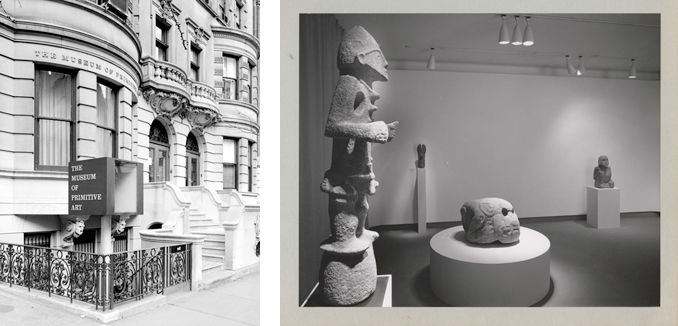
Left: View of the façade of the Museum of Primitive Art, 15 West 54th Street, New York City. The Museum of Primitive Art Records, The Department of the Arts of Africa, Oceania, and the Americas, The Metropolitan Museum of Art, New York, AR.1999.17.98. Right: Exhibition view, Exhibition 1, Selected Works from the Collection, The Museum of Primitive Art, February 20–May 19, 1957. The Museum of Primitive Art Records, The Department of the Arts of Africa, Oceania, and the Americas, The Metropolitan Museum of Art, New York, AR.1999.1.3
1958: Rockefeller acquires a Benin ivory pendant mask for a record price for a work of "primitive" art.
Selected Works Four displays the MPA's collection of ancient Peruvian textiles and featherwork.
1959: Rockefeller's son, Michael, becomes an MPA Trustee.
The exhibition The Art of Lake Sentani is presented at the MPA.
Nelson Rockefeller is elected as the fourteenth governor of New York.
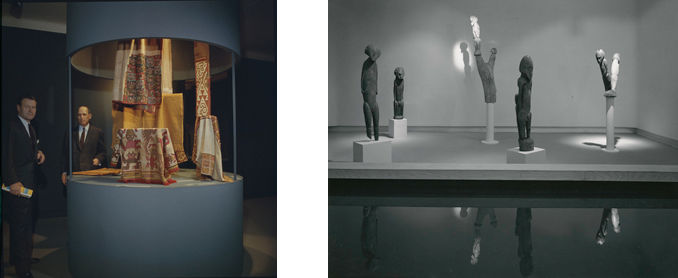
Left: Exhibition view with Nelson A. Rockefeller and Robert Goldwater, Exhibition 4, Art of Ancient Peru, February 19–May 18, 1958. Rockefeller Family Archives. Courtesy of Rockefeller Archive Center, NAR RG 4, Project Series Box 164, Folder 1662. Right: Exhibition view, Exhibition 9, The Art of Lake Sentani, Museum of Modern Art, September 16, 1959–February 7, 1960, The Museum of Primitive Art Archives, The Department of the Arts of Africa, Oceania, and the Americas, The Metropolitan Museum of Art, New York, AR.1999.1.20.
1961: Art Styles of the Papuan Gulf opens at the MPA.
Michael Rockefeller joins the Harvard-Peabody New Guinea Expedition to the Baliem Valley in western New Guinea and makes his first collecting trip to the Asmat region. He is lost while on a second collecting trip to the Asmat later that year.

Left: Michael Rockefeller kneeling on the ground with recording equipment, surrounded by a dance circle in the Highlands of western New Guinea, 1961. Photograph by Eliot Elisofon. © President and Fellows of Harvard College, Peabody Museum of Archaeology and Ethnology, PM# 2006.37.1.15.30, digital file number, 155700079. Right: Exhibition view, Exhibition 25, Art of the Asmat, New Guinea: Collected by Michael C. Rockefeller, The Museum of Modern Art, September 11–November 6, 1962. The Museum of Primitive Art Records, The Department of the Arts of Africa, Oceania, and the Americas, The Metropolitan Museum of Art, New York, AR.1999.17.47.
1962: MPA exhibition The Art of the Asmat, New Guinea: Collected by Michael C. Rockefeller, designed by d'Harnoncourt with assistance of Newton, opens in a specially built pavilion in MoMA's courtyard.
1963: Under Goldwater's direction, MPA presents Senufo Sculpture from West Africa.
Mary Rockefeller Morgan is elected to MPA Board of Trustees.
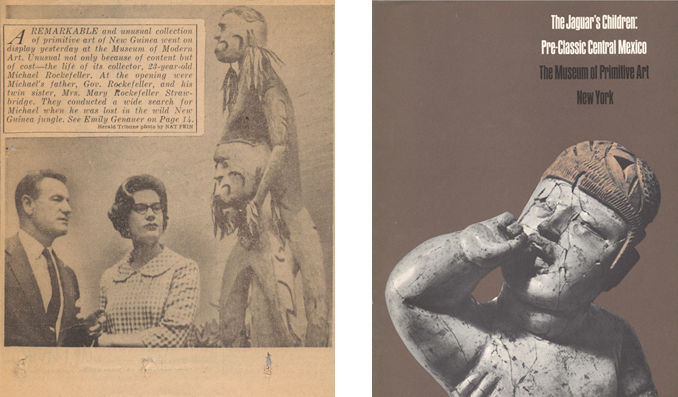
Left: Press clipping with Nelson A. Rockefeller and his daughter Mary Rockefeller Morgan at the opening of the exhibition Art of the Asmat, New Guinea: Collected by Michael C. Rockefeller, New York Herald Tribune, September 12, 1961. The Museum of Primitive Art Records, The Department of the Arts of Africa, Oceania, and the Americas, The Metropolitan Museum of Art, New York, AR.1999.1.40. Right: Exhibition catalogue, The Jaguar's Children: Pre-Classic Central Mexico, Michael D. Coe. New York, N.Y. : Museum of Primitive Art ; distributed by the New York Graphic Society, Greenwich, Conn., 1965 The Metropolitan Museum of Art, Robert Goldwater Library, T7P A11 C67 REF
1965: MPA loan show, The Jaguar's Children: Pre-Classic Central Mexico, focuses on the complex history of the early peoples of that region in the mid-1st millennium B.C.
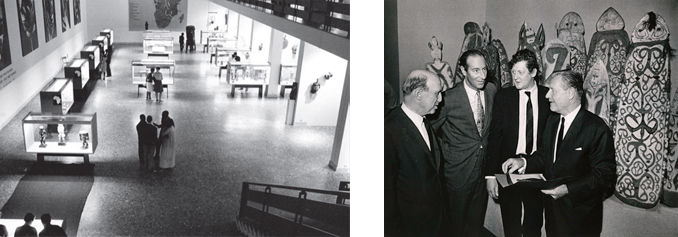
Left: Exhibition view, Art nègre: sources, évolution, expansion, at the Musée dynamique de Dakar during the First World Festival of Negro Arts, 1966, Dakar, Senegal. © Courtesy of École du Louvre, Paris. All rights reserved. Right: Robert Goldwater, Thomas Hoving, Douglas Newton, Nelson A. Rockefeller, at The Metropolitan Museum of Art press event announcing the transfer of the Museum of Primitive art’s collection, library, and staff to the Met, May 1969. Photograph by Michael Fredericks.
1966: First World Festival of Negro Arts (1er Festival Mondial des Arts Nègres) held in Dakar, Senegal. The MPA lends twenty-three works on this occasion.
1967: MPA publishes The Asmat of New Guinea: The Journal of Michael Clark Rockefeller, containing Michael Rockefeller's notes and photographs and a catalogue of the Asmat works he collected.
1969: Art of Oceania, Africa, and the Americas from The Museum of Primitive Art opens at the Met to introduce the Museum's public to the Rockefeller collections.
Rockefeller signs an agreement to transfer the MPA's collection, staff, and library to the Met.
1974: Newton succeeds Goldwater as Director of MPA and is appointed Chairman for the Met's Department of Primitive Art.
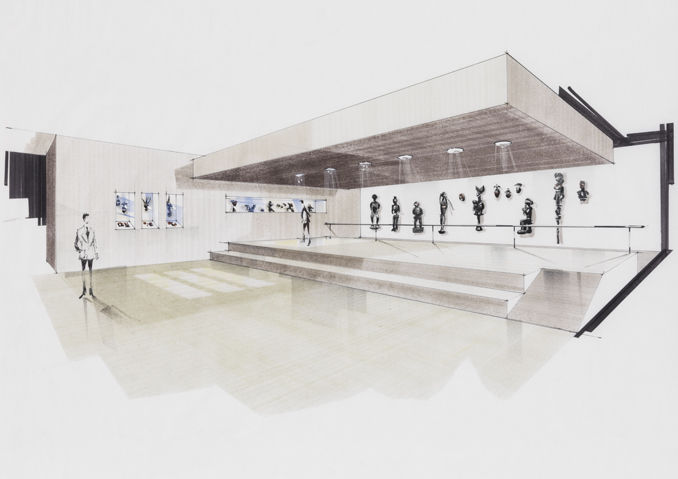
Architectural rendering of the Michael C. Rockefeller Wing elevated gallery area for the Arts of Africa, 1975-1981. The Museum of Primitive Art Records, The Department of the Arts of Africa, Oceania, and the Americas, The Metropolitan Museum of Art, New York, AR.1999.19.47.
Construction of the Michael C. Rockefeller Wing begins, designed by architects at Kevin Roche John Pinkeloo and Associates.
Mary R. Morgan is elected to the MMA Board of Trustees.
MPA closes its doors to the public.
1978 to 1979: MPA collection, staff, and library are transferred to the Met.
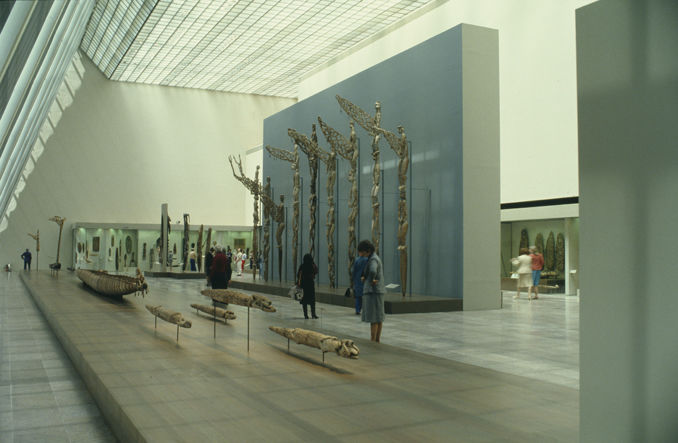
View of the recently opened Oceanic art gallery in the Michael C. Rockefeller Wing, The Metropolitan Museum of Art, 1982. The Department of the Arts of Africa, Oceania, and the Americas, The Metropolitan Museum of Art, New York.
1982: Michael C. Rockefeller Wing opens at the Met.
1991: The Met's board of trustees votes to rename the "Department of Primitive Art," the "Department of the Arts of Africa, Oceania, and the Americas."